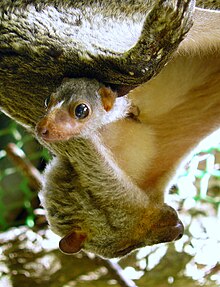| Philippine flying lemur | |
|---|---|

| |
| Scientific classification | |
| Domain: | Eukaryota |
| Kingdom: | Animalia |
| Phylum: | Chordata |
| Class: | Mammalia |
| Order: | Dermoptera |
| Family: | Cynocephalidae |
| Genus: | Cynocephalus Boddaert, 1768 |
| Species: | C. volans
|
| Binomial name | |
| Cynocephalus volans | |

| |
| Philippine flying lemur range | |
| Synonyms | |
| |
The Philippine flying lemur or Philippine colugo (Cynocephalus volans), known locally as kagwang, is one of two species of colugo or "flying lemurs". It is monotypic of its genus. Although it is called "flying lemur", the Philippine flying lemur is neither a lemur nor does it fly. Instead, it glides as it leaps among trees.
The kagwang belongs to the order Dermoptera that contains only two species, one of which is found in the Philippines, while the other, the Sunda flying lemur, is found in Indonesia, Thailand, Malaysia, and Singapore. Recent research from genetic analysis suggests two other species, the Bornean flying lemur and the Javan flying lemur, may exist, as well, but they have yet to be officially classified.
Both species of Dermoptera are classified under the grandorder Euarchonta, which includes treeshrews and primates, as well as an extinct order of mammals, the Plesiadapiformes.[3]
- ^ Gonzalez, J.C.; Custodio, C.; Carino, P.; Pamaong-Jose, R. (2008). "Cynocephalus volans". IUCN Red List of Threatened Species. 2008: e.T6081A12410826. doi:10.2305/IUCN.UK.2008.RLTS.T6081A12410826.en. Retrieved November 19, 2021.
- ^ Linnæus, Carl (1758). Systema naturæ per regna tria naturæ, secundum classes, ordines, genera, species, cum characteribus, differentiis, synonymis, locis. Tomus I (in Latin) (10 ed.). Holmiæ: Laurentius Salvius. p. 30. Retrieved November 21, 2012.
- ^ Moritz, Gillian L.; Lim, Norman T.-L.; Neitz, Maureen; Peich, Leo; Dominy, Nathaniel J. (2013). "Expression and Evolution of Short Wavelength Sensitive Opsins in Colugos: A Nocturnal Lineage That Informs Debate on Primate Origins". Journal of Evolutionary Biology. 40 (4): 542–553. Bibcode:2013EvBio..40..542M. doi:10.1007/s11692-013-9230-y. PMC 3832777. PMID 24293738.
